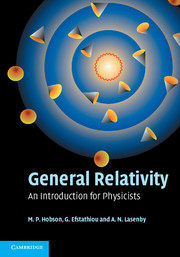Book contents
- Frontmatter
- Contents
- Preface
- 1 The spacetime of special relativity
- 2 Manifolds and coordinates
- 3 Vector calculus on manifolds
- 4 Tensor calculus on manifolds
- 5 Special relativity revisited
- 6 Electromagnetism
- 7 The equivalence principle and spacetime curvature
- 8 The gravitational field equations
- 9 The Schwarzschild geometry
- 10 Experimental tests of general relativity
- 11 Schwarzschild black holes
- 12 Further spherically symmetric geometries
- 13 The Kerr geometry
- 14 The Friedmann–Robertson–Walker geometry
- 15 Cosmological models
- 16 Inflationary cosmology
- 17 Linearised general relativity
- 18 Gravitational waves
- 19 A variational approach to general relativity
- Bibliography
- Index
9 - The Schwarzschild geometry
Published online by Cambridge University Press: 05 September 2012
- Frontmatter
- Contents
- Preface
- 1 The spacetime of special relativity
- 2 Manifolds and coordinates
- 3 Vector calculus on manifolds
- 4 Tensor calculus on manifolds
- 5 Special relativity revisited
- 6 Electromagnetism
- 7 The equivalence principle and spacetime curvature
- 8 The gravitational field equations
- 9 The Schwarzschild geometry
- 10 Experimental tests of general relativity
- 11 Schwarzschild black holes
- 12 Further spherically symmetric geometries
- 13 The Kerr geometry
- 14 The Friedmann–Robertson–Walker geometry
- 15 Cosmological models
- 16 Inflationary cosmology
- 17 Linearised general relativity
- 18 Gravitational waves
- 19 A variational approach to general relativity
- Bibliography
- Index
Summary
We now consider how to solve the Einstein field equations and so discover the metric functions gμν in any given physical situation. Clearly, the high degree of non-linearity in the field equations means that a general solution for an arbitrary matter distribution is analytically intractable. The problem becomes easier if we look for special solutions, for example those representing spacetimes possessing symmetries. The first exact solution to Einstein's equations was found by Karl Schwarzschild in 1916. As we shall see, the Schwarzschild solution represents the spacetime geometry outside a spherically symmetric matter distribution.
The general static isotropic metric
Schwarzschild sought the metric gµν representing the static spherically symmetric gravitational field in the empty space surrounding some massive spherical object such as a star. Thus, a good starting point for us is to construct the most general form of the metric for a static spatially isotropic spacetime.
A static spacetime is one for which some timelike coordinate x0 (say) with the following properties: (i) all the metric components gµν are independent of x0; and (ii) the line element ds2 is invariant under the transformation x0 → −x0. Note that (i) does not necessarily imply (ii), as is made clear by the example of a rotating star: time reversal changes the sense of rotation, but the metric components are constant in time. A spacetime that satisfies (i) but not (ii) is called stationary.
- Type
- Chapter
- Information
- General RelativityAn Introduction for Physicists, pp. 196 - 229Publisher: Cambridge University PressPrint publication year: 2006



